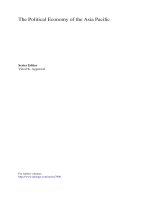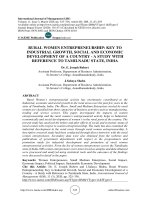Economic growth and economic development 352
Bạn đang xem bản rút gọn của tài liệu. Xem và tải ngay bản đầy đủ của tài liệu tại đây (116.69 KB, 1 trang )
Introduction to Modern Economic Growth
be a necessary condition for this alternative maximization problem. Therefore,
the Maximum Principle is implicitly maximizing the sum the original maximand
R t1
R t1
f
(t,
x
ˆ
(t)
,
y
(t))
dt
plus
an
additional
term
λ (t) g (t, xˆ (t) , y (t)) dt. Under0
0
standing why this is true provides much of the intuition for the Maximum Principle.
First recall that V (t, xˆ (t)) is defined in equation (7.33) as the value of starting
at time t with state variable xˆ (t) and pursuing the optimal policy from then on.
We will see in the next subsection, in particular in equation (7.43), that
∂V (t, xˆ (t))
.
∂x
Therefore, similar to the Lagrange multipliers in the theory of constraint optiλ (t) =
mization, λ (t) measures the impact of a small increase in x on the optimal value
of the program. Consequently, λ (t) is the (shadow) value of relaxing the constraint (7.29) by increasing the value of x (t) at time t.6 Moreover, recall that
x˙ (t) = g (t, xˆ (t) , y (t)), so that the second term in the Hamiltonian is equivalent to
R t1
λ (t) x˙ (t) dt. This is clearly the shadow value of x (t) at time t and the increase
0
in the stock of x (t) at this point. Moreover, recall that x (t) is the state variable,
thus we can think of it as a “stock” variable in contrast to the control y (t), which
corresponds to a “flow” variable.
Therefore, maximizing (7.40) is equivalent to maximizing instantaneous returns
as given by the function f (t, xˆ (t) , y (t)), plus the value of stock of x (t), as given
by λ (t), times the increase in the stock, x˙ (t). This implies that the essence of the
Maximum Principle is to maximize the flow return plus the value of the current
stock of the state variable. This stock-flow type maximization has a clear economic
logic
Let us next turn to the interpreting the costate equation,
λ˙ (t) = −Hx (t, xˆ (t) , yˆ (t) , λ (t))
= −fx (t, xˆ (t) , yˆ (t)) − λ (t) gx (t, xˆ (t) , yˆ (t)) .
This equation is also intuitive. Since λ (t) is the value of the stock of the state
variable, x (t), λ˙ (t) is the appreciation in this stock variable. A small increase in x
6Here I am using the language of “relaxing the constraint” implicitly presuming that a high
value of x (t) contributes to increasing the value of the objective function. This simplifies terminology, but is not necessary for any of the arguments, since λ (t) can be negative.
338









